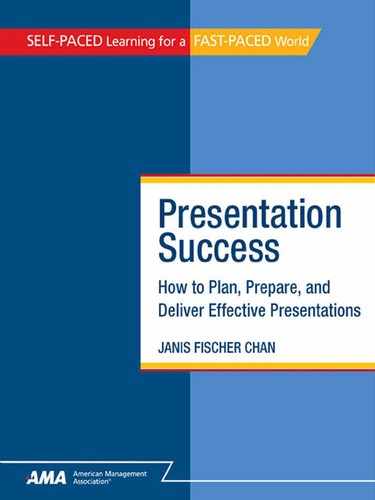Appendix: B
Presentation Job Aids
Use the job aids in this appendix for quick reference when planning and preparing a presentation. These reproducible job aids list the key steps and techniques for:
• Dealing with anxiety and stage fright (p. 15)
• Relaxing before and during a presentation (p. 16)
• Planning your presentation (p. 26)
• Analyzing your audience (p. 27)
• Choosing your presentation format (p. 33)
• Crafting effective openings and closings (p. 57)
• Selecting and using presentation aids (p. 101)
For complete descriptions of these steps and techniques, please refer to the pages listed above.
STEPS YOU CAN TAKE TO REDUCE ANXIETY
• Identify the reasons for your anxiety
• Ask yourself what you can do to improve the situation
• Direct your energy
• Make backup plans
• Take care of yourself
STEPS YOU CAN TAKE TO REDUCE STAGE FRIGHT
• Arrive early
• Make eye contact with members of the audience
• Use silence
• Move
• Acknowledge your stage fright
• Relax
EXERCISES TO HELP YOU RELAX BEFORE THE PRESENTATION
• Visualize
• Meditate
• Exercise
RELAXATION EXERCISES BEFORE AND DURING THE PRESENTATION
• Breathe
• Release tension as it occurs
• Yawn
• Loosen your neck and shoulders
• Relax your face
THE PLANNING STEPS
• Step 1: Evaluate the audience.
• Step 2: Define the presentation objectives.
• Step 3: Determine what presentation methods to use.
• Step 4: Select the information to include and organize it effectively.
• Step 5: Identify where to use presentation aids.
WHAT YOU SHOULD KNOW ABOUT YOUR AUDIENCE
• How large is the audience?
• What are audience members’ relevant characteristics?
• Why are people attending?
• What are the audience’s specific needs, interests, and concerns?
• How much do people already know?
• How are people likely to respond to your message?
COMMON TYPES OF PRESENTATIONS
• Speech
• Informal talk
• Facilitated discussion
• Demonstration
• Class
GUIDELINES FOR EFFECTIVE OPENINGS
• Always prepare your opening.
• Tell people what the presentation is about.
• Keep the opening short and simple.
• Only use anecdotes that are relevant.
• Use caution with personal experiences.
• Stay away from inappropriate humor.
GUIDELINES FOR CLOSINGS
• Always prepare a closing.
• Always restate the main point and, perhaps, the key supporting points.
• Say clearly what happens next.
• If appropriate, make a call to action.
• Thank the audience.
GUIDELINES FOR PRESENTATION AIDS
• Have a good reason for using a presentation aid.
• Make sure the presentation aid is worth the time and cost.
• Recognize that the risk of problems increases when you use complicated equipment.
• Keep visuals simple and clear.
• Direct the audience’s attention.
• Don’t flash visuals by too quickly.
• Make sure equipment is operating properly before you begin.
• Talk to your audience, not your visuals.
• Don’t hide behind the equipment.
